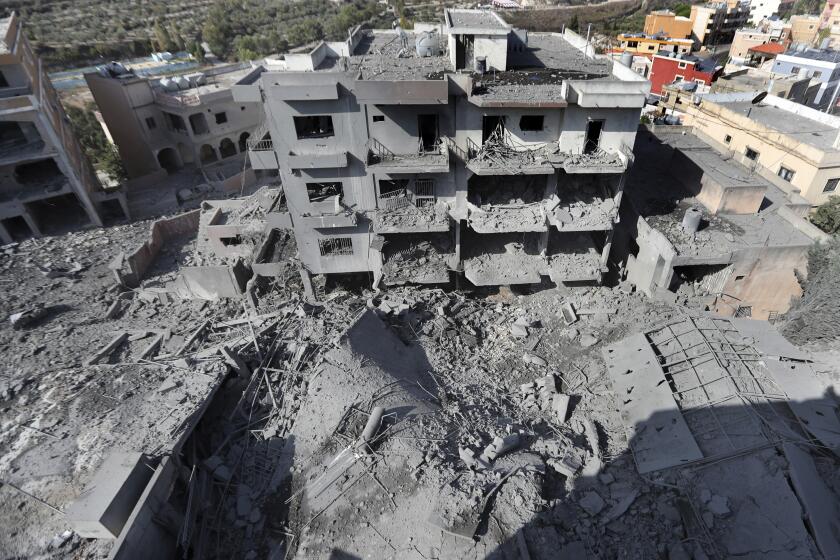Rescue In Space : NASA RACES TO PREVENT SATELLITE’S FALL TO EARTH
The space agency is racing against time to rescue a research satellite the size of a school bus that is threatening to tumble from orbit and crash to Earth.
The satellite, called the Long Duration Exposure Facility, was to have remained in orbit for only one year, but it has been there for more than five years because of the chaos in the launch schedule resulting from the Challenger accident. The National Aeronautics and Space Administration has long been aware that the satellite could send 100-pound chunks of debris crashing to Earth if it is not rescued.
NASA has scheduled a Dec. 18 launch of the space shuttle to pluck the unique satellite from its rapidly deteriorating orbit.
That 11th-hour attempt could be just in the nick of time, although there is no guarantee that such a late date will be soon enough, and there is virtually no possibility of moving it up.
“That looks like it will be OK, but it will be close,” said William H. Kinard of NASA’s Langley Research Center, the project’s chief scientist. “There is a great deal of uncertainty,” he added.
Much will be riding on the effort.
The Long Duration Exposure Facility is the only satellite launched to study the impact of prolonged exposure to space, and it carries 56 experiments designed to measure such things as the effects of being constantly bombarded by tiny particles and potentially damaging radiation. But since it has been in space so long, the entire satellite is now of profound interest to scientists and engineers because it should tell much about how satellites age in space.
Among the most interested observers are scientists with the Strategic Defense Initiative, commonly known as Star Wars, who have mounted a strong campaign to compel NASA to give the rescue a high priority.
Kinard had hoped the rescue could be accomplished by the middle of this summer “to get us out of the woods,” but the launch schedule for the three-orbiter shuttle fleet is too tight to allow that, NASA officials have concluded.
Clearly, time is running out.
Tracking of the 30-foot-long satellite by the North American Defense Command reveals that between Nov. 1, 1987, and April 25, 1989, the craft descended from an orbit of 290 miles to 264 miles. The orbit has dropped far more rapidly in recent months, and by December the craft is expected to be no more than about 167 miles above Earth. At that rate, by next Jan. 7, the satellite would begin to tumble and break up, sending chunks raining down on the planet.
Furthermore, the orbit could decay far more rapidly if sunspot activity rises significantly. The sun has entered an active phase, which causes Earth’s atmosphere to expand, pushing denser air to higher elevations. That causes more drag on the spacecraft, thus slowing it down and pushing it closer to the ground.
But Kinard believes the sun may smile on the retrieval effort.
“The general level of (solar) activity has been down for the last three months or so, which has been very much appreciated by us,” he said in a telephone interview. “The 90-day forecast from the National Oceanic and Atmospheric Administration indicates a moderate level of activity,” offering some hope that the orbit will not degrade more rapidly than anticipated.
If that forecast holds up, the satellite should maintain sufficient altitude for the rescue attempt, he said.
All will be lost, however, if the craft cannot be rescued because all the experiments aboard the 10.7-ton satellite were designed to be retrieved and no data from the unexpectedly long journey can be saved if it plunges from orbit. Most satellites transmit their data back to Earth.
“All of the experiments are dependent on retrieval,” Kinard said. “We have no communications with the spacecraft at all. We have to get it back.”
Because of the duration of the flight, the spacecraft itself is probably of more scientific value than the experiments it carries, he noted.
The satellite is a “free-flier,” meaning it has no propulsion system, and it consists mainly of a cylindrical frame designed to hold up to 86 experimental trays. The heart of the structure is a series of aluminum rings and rods welded and bolted together.
Since it has been exposed to space for so long, “everything on the spacecraft is of interest,” Kinard said.
“Has the aluminum become radioactive” from constant bombardment by charged particles? he asked. “Have the strength properties changed, do the mechanical systems still work? What about the hinges, motors, latches, lubrications, data systems? Everything on it is of extreme interest.”
That is particularly true for scientists with the Strategic Defense Initiative, who envision the day when the planet will be surrounded by space-based tools of war. Such hardware must work flawlessly and endure long exposure to the same elements that have been attacking the Long Duration Exposure Facility for more than five years.
At this point, no one knows for sure how severely satellites degrade over the years. No other spacecraft has ever been launched to study that--much less retrieved--so the satellite offers scientists a unique chance to learn whether space is hostile to human intrusions.
Kinard said the satellite has been hit many times by debris, both man-made and natural.
“We expect to find thousands of craters on it, from microscopic craters to some that will be apparent to the naked eye,” he said.
That will be of great interest to scientists who are concerned about the debris that humans have put into space. Every time a rocket blasts through the atmosphere, it contributes some junk to space. More than 7,000 large pieces are now being tracked.
Many of them are pieces of shrapnel from satellites that exploded while trying to reach orbit, sending debris zipping around the planet at more than 17,000 m.p.h. Some experts fear it is only a matter of time before one of them slices through a manned spacecraft.
Nature also supplies a fair share of hazards. A team of French scientists has an experiment aboard the satellite designed to study the impact of interplanetary dust particles, called micrometeoroids, on a wide range of materials that have been exposed to space throughout the long flight.
Cosmic rays, which are shielded from Earth by its atmosphere, could prove lethal to humans during long space flights, and a team of German scientists has an experiment aboard the satellite designed to analyze that hazard.
Even a “passive” spacecraft like the Long Duration Exposure Facility contributes a little to the space debris problem. When a spacecraft orbits Earth, it is constantly bombarded by atomic oxygen and that in turn causes some materials to “outgas” other products. That process is of concern to astronomers who fear that any outgassing could contaminate images from orbiting telescopes. A team of scientists from NASA’s Marshall Space Flight Center have an experiment aboard to study that problem.
The satellite even carries about 12 million tomato seeds as part of a NASA experiment. The seeds are to be distributed to student groups around the country, who will plant them. The purpose is to learn if exposure to space will have any impact on farmers of the future who will be expected to grow some of their food during long voyages to such distant places as Mars.
All of that will be lost, however, if the satellite cannot be retrieved.
More to Read
Sign up for Essential California
The most important California stories and recommendations in your inbox every morning.
You may occasionally receive promotional content from the Los Angeles Times.










